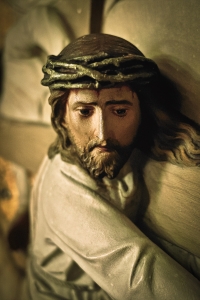 Did Jesus really sin? Apparently nearly 60% of all practicing Catholic within the Diocese of Camden, NJ believe so. This was the findings of a religious survey commissioned by the Diocese of Camden for all intense purposes to find out what people know and understand about their Catholic faith. These results should put all of us on alert regarding the lack of fundamental Catholic knowledge Camden Bishop Joseph Galante called both “disturbing” and “intriguing”.
Did Jesus really sin? Apparently nearly 60% of all practicing Catholic within the Diocese of Camden, NJ believe so. This was the findings of a religious survey commissioned by the Diocese of Camden for all intense purposes to find out what people know and understand about their Catholic faith. These results should put all of us on alert regarding the lack of fundamental Catholic knowledge Camden Bishop Joseph Galante called both “disturbing” and “intriguing”.
Not wasting any time in interpreting the results, Bishop Galante attributed these disturbing results to a lack of Mass attendance which in his assessment attributes to the faithful being born “out of the Church.” No one should be completely surprised at these results. This survey provides us with a genuine wake-up call on the need to reclaim our lost Catholic identity and clarify the misunderstandings of Church teaching.
How We Got to This Point: The “Jesus Loves Me” Model
You may be wondering how in the world so many people could believe Jesus actually sinned. The decade of the seventies introduced us to the “Jesus loves me” catechetical model. This particular method stressed Jesus as our friend. This sounds fine until you realize that this particular teaching method leaves out several key doctrinal points i.e.
- Jesus as the Son of God
- Jesus the second person of the Blessed Trinity
- Jesus the Divine Teacher
- Jesus the Lord of History
- Jesus the Messiah
- Jesus the Word made flesh
- Jesus our Savior and King
If Jesus did indeed sin, then the doctrinal points just mentioned contradict the “Jesus-friend model.” Many catechists during this time period emphasized the person of Jesus rather than the Divinity of Jesus. This mind created a catechesis from below rather than one from above (Col 3:1-3). Our understanding of Christ was based on our own personal experience and not what the Church taught. In other words, catechesis became a “me centered” approach rather than a “Christ-centered” approach.
A Continual Problem
“Jesus loves me” does not sound heretical in nature, nor does it profess to ignore the very mission of Christ on the Cross (Jn 12:27-36; Mt 27:32-44; Lk 23:26-43; 1 Cor 13:1-13). However, when you manipulate Christ’s love to mean something it truly is not you then have a catechetical dilemma of people believing that Jesus actually sinned. An ominous sign revealing the problems the Diocese of Camden face are seen in the comments made by a parish Director of Religious Education (DRE) who said: “We tell our kids that Jesus had a childhood just like them. So they think that includes sin.” This is a great example of the “Jesus is my friend” methodology still in existence today. Yes, Jesus was indeed fully human having all the characteristics of man except sin! See: CCC 456-460, 461
Oh, the Humanity!
The “Humanity of Jesus Catechetical Model” became a staple in many catechetical programs and texts used throughout the country in the seventies and eighties. The catechetical text themselves contained images of Jesus holding hands with children, or Jesus running through a field and smiling at everyone and so on. At no time do you see any specific reference to the Divinity of Christ, in particular imagery of the Last Supper, the Agony in the Garden, or the Crucifixion because they were considered “too much” for children to understand. These examples quite frankly were the catechetical methods employed by some of my own CCD and Catholic School teachers.
How Should We Teach? The Need for Sound Catechist Formation
The most telling statement of the entire article was a question posed by the parish DRE: “How do we teach our kids the humanity of Jesus without sin?” And here lies the problem; teaching the humanity of Jesus while forgetting one important point, He’s God!
The apparent assumption here is that a child could not possibly relate to Jesus as Messiah, Lord, and Savior. Hence, no need to teach on the true presence of Christ in the Holy Eucharist (this may be one explanation on why the lack of mass attendance is so prevalent). A second possible assumption is teaching the doctrine of sin would traumatize a child to the point of not identifying with Jesus at all. Keep this mind, if we were to actually follow this methodology here are some of the key doctrines that might be bypassed:
- The Blessed Trinity, the Annunciation, the Immaculate Conception, the Incarnation, the Hypostatic Union, Original Sin etc.
You may think I’m kidding, but this stark reality reflects the need for sound catechist formation, especially in Catholic doctrine and methodology.
Instead of:
- Systematically teaching students how the Mass is integrally tied to the death of Christ on the Cross and; (1 Cor 11:23-26)
- Teaching how His sacrifice was the result of God’s love for his Children that he offered His Son to be crucified for the sins of many (Jn 3:16; Jn 6:45-52);
- Teaching how the Crucifixion visibly identifies the love of God for his children; (CCC 599-603)
They were taught:
- “Jesus loves you” no matter what you do, even if you sin. The catch here is there was no specific intent to clearly define why Christ indeed loves us. He came to defeat the power of sin.
- “Jesus is your friend”, and not “Jesus is the Son of God”, the Second person of the Blessed Trinity. (CCC 441-451)
- Sin is not really sin; it’s just mistakes we make. Jesus loves us anyway. (Confession?)
- Jesus is everywhere i.e. you don’t need to go to Mass. (Prayer?)
- Jesus would never scold you, he loves you. (Penitent?)
A Return to the Basics
Whether it’s Jesus sinning or the Blessed Mother not being a Virgin, there is a real need for sound, systematic catechesis. Blessed John Paul II reminded us that the aim of catechesis is to place the person into an intimate communion with Jesus Christ (Catechesis In Our Time, 5). The first step in any teaching plan lies on the teacher leading the student towards an authentic relationship with Jesus Christ by authentic witness and instruction.
Our catechetical renewal should always affirm who Christ is as the only-begotten son; the Second Person of the Blessed Trinity who emptied himself taking the form of a servant . . . (2 Phil 2:6-11). Incorporating Sacred Scripture and the Catechism of the Catholic Church doesn’t hurt either. These two resources provide us with a complete exposition of the Church’s teaching. We really can’t assume that the mysteries of Christ are beyond our understanding. The reality of Divine Revelation i.e. God’s spoken Word was given to us so that we can understand the Mystery of Christ in an organic, visible way.
Prayer serves and the conduit towards all forms of catechetical instruction because it’s open communication with God. The Sign of the Cross, Our Father, Apostles Creed and the Hail Mary are the perfect conduits to forge a renewal for the better.
Blessed John Paul II, Pray for us!
Copyright 2013 Marlon De La Torre
About the Author

Marlon De La Torre
Marlon currently serves as the Director of Catechist Formation and Children’s Catechesis for the Catholic Diocese of Fort Worth. He is an adjunct professor of Catechetics for Holy Trinity Seminary serving the Diocese of Dallas and Fort Worth and an adjunct professor of Catechetics for The Catholic Distance University. His published works include Screwtape Teaches the Faith. Learn more about Marlon's work at his blog Knowing Is Doing.


.png?width=1806&height=731&name=CatholicMom_hcfm_logo1_pos_871c_2728c%20(002).png)
Comments